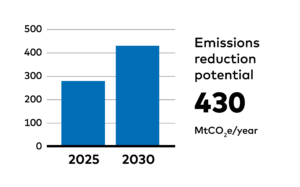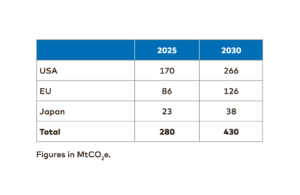Climate impact
Sweden has been able to reduce energy use per area in buildings by 1.9% a year in 2002–13. Both heating and electricity use per square metre have declined in all main building types.
Similar progress can be expected from countries in comparable economic and climate conditions. If they were to achieve the same annual reduction in energy use per square metre as Sweden, this would cut emissions by 280 Mt in 2025 and 340 Mt in 2030.


Success factors
Average energy consumption per square metre has shown a downward trend in all Nordic countries in the last decade. However, Sweden is the only country where also the absolute energy consumption has declined, by close to 1% per year, despite the moderate growth in economy, population and building mass.
Nordic governments and industry have paid attention to improving energy efficiency in buildings. There has recently been a trend towards very lowor even net-zero energy buildings. Countries have also improved efficiency standards for lighting and appliances as part of the European internal market.
Sweden has organised technology procurement groups which cooperate on procuring efficiency technologies and exchange experiences. Some 20% of all commercial space and 70% of all apartment buildings are estimated to be covered by such groups. Efficiency requirements in the building codes have also been ramped up. Information about opportunities for efficiency improvements is actively distributed through municipal climate and energy advisors as well as the Swedish Energy Agency.
“Sweden has cut energy use in buildings despite the growth in economy and population.”
Costs
The relevant measures are quite diverse. That is why the unit costs range from more than 70 $/tCO2 to savings of more than –130 $/tCO2. However, the most commonly used measures vary between approximately 0 and –40 $/tCO2. We apply this range to estimate the net abatement cost in both 2025 and 2030.


Co-benefits
Improving energy efficiency in buildings can provide several co-benefits, such as
- cutting harmful air pollution
- increasing housing quality
- improving energy security
Barriers and drivers
Energy efficiency improvements in buildings often produce net savings, but the payback time can be long. More importantly, the savings often accrue to tenants rather than those making decisions about investments (developers and landlords). Policy makers therefore need to put in place explicit requirements such as building codes and possibly also financial incentives such as tax credits.
In areas with low energy prices, there is only little incentive to care about energy efficiency measures. Raising taxes on energy use in buildings can increase the attractiveness of efficiency improvements.
Awareness of energy efficiency in buildings is often low. Therefore, information and awareness campaigns are important. Regulatory requirements will also signal that energy efficiency is a priority, helping to raise awareness.






RELATED SOLUTIONS